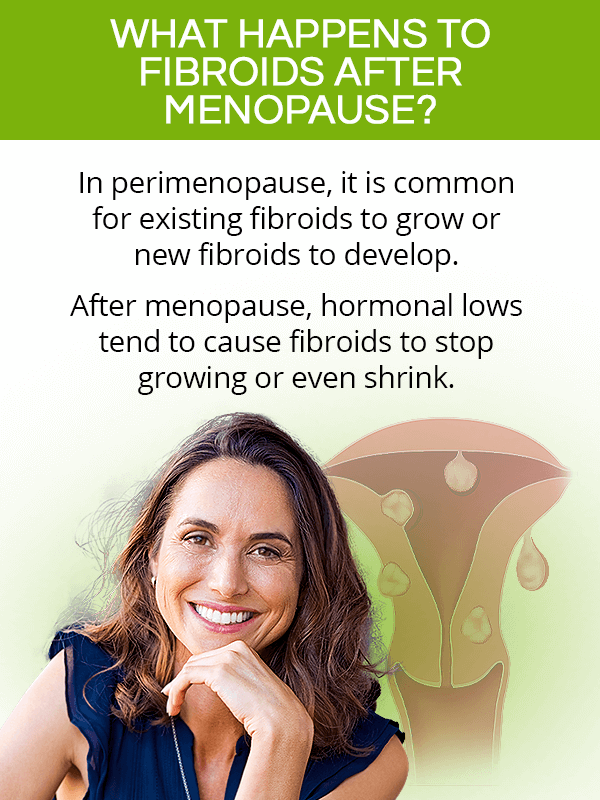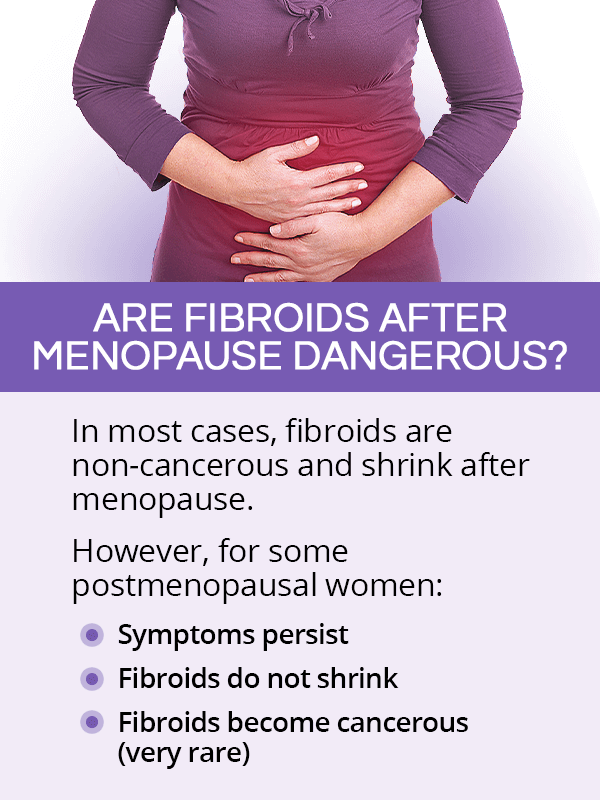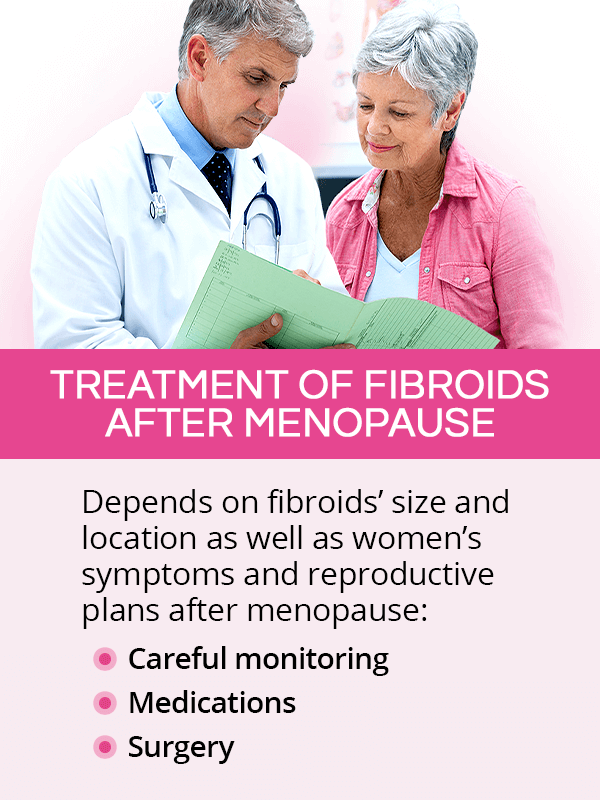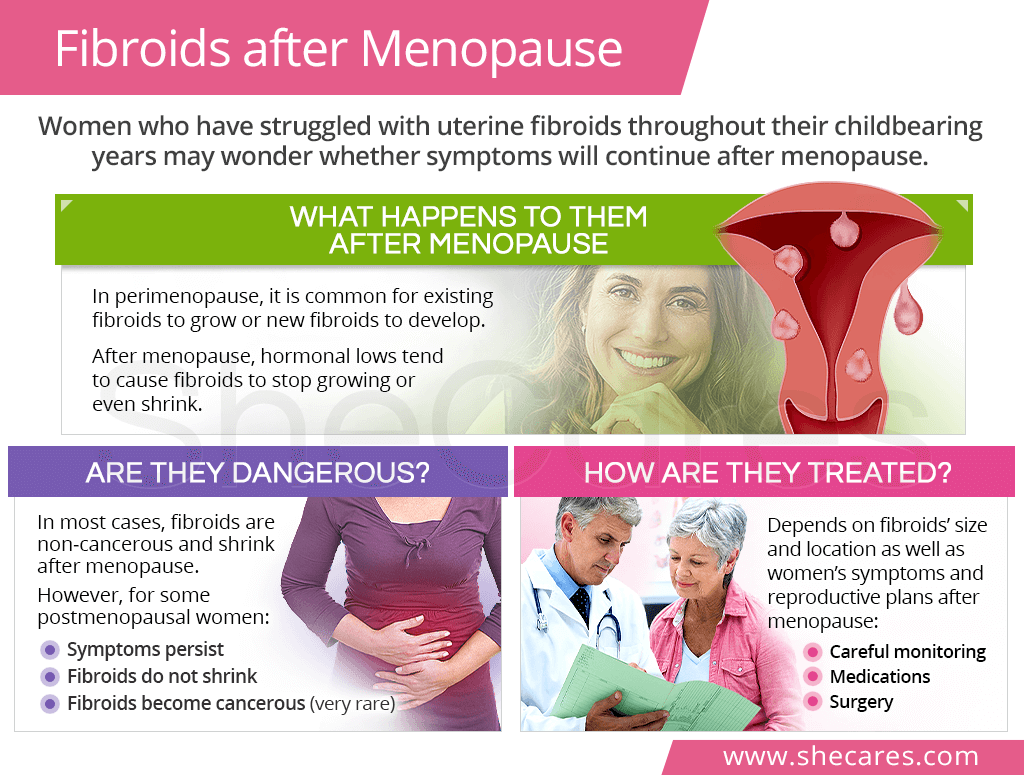What are Fibroids?
Fibroids are mostly non-cancerous muscular growths that develop in the uterine wall. They may vary in size and number. It is possible for a woman to have several fibroids in her uterus.
Most women do not experience any fibroid symptoms and many may not even know they have them.
Those who do experience discomforts generally report varying degrees of feeling pelvic pressure or fullness, heavy bleeding, frequent urination, constipation, lower back pain, and painful sex, among others.
What Happens to Fibroids After Menopause?

Research is not clear on what causes uterine fibroids and what affects their growth. However, it has been observed that their development is related to reproductive hormones.
Fibroids and Perimenopause
Perimenopause is a point in women's lives when their ovarian production of estrogen and progesterone erratically fluctuates. This may make existing fibroids grow larger or cause new fibroids to develop in the uterine wall.
In fact, perimenopause is one of the main risk factors associated with uterine fibroid development.1 Studies have shown that up to 30% of women develop fibroids during their reproductive years.2 Up to 80% of women will be diagnosed with fibroids past their 50s.3
Fibroids after Menopause
From the moment women reach menopause, or go without a period for 12 months in a row, their estrogen and progesterone levels remain low. In most cases, fibroids tend to stop growing or even shrink.
However, that is not true for all postmenopausal women. Studies have shown that women of African American descent are less likely to experience fibroid shrinkage after menopause than white women of the same menopausal status.4
Also, fibroids in menopausal women taking hormone replacement therapy (HRT) may not shrink as HRT contains estrogen and progesterone.
Are Fibroids After Menopause Dangerous?

As aforementioned, in a great majority of cases, uterine fibroids are benign (non-cancerous) and shrink after menopause. New fibroids are also not likely to develop in postmenopausal women.
However, although rare, there have been incidences of degenerative changes in existing fibroids in postmenopausal women, causing acute symptoms.5
A rapid fibroid growth after menopause may also signal a transformation of a fibroid into a very rare type of cancer, called leiomyosarcoma. These risks warrant careful monitoring of fibroids in postmenopause.
In addition, it is essential to keep in mind that any vaginal bleeding after menopause should be evaluated by a doctor right away.
Treatment of Fibroids after Menopause

For women who do not struggle with major symptoms, there is generally no need for any treatment for fibroids after menopause. Regular check-ups can help monitor their size and adjust care accordingly along the way.
However, women with intense symptoms may be recommended a variety of treatments, including the following:
Medications for Fibroids after Menopause
Currently available medications for fibroids do not cure them; rather, they help manage symptoms they may cause, such as heavy bleeding. In some cases, medications may also be used to control symptoms or shrink fibroids before surgery.
Pain relievers, like acetaminophen or ibuprofen, may help relieve mild to moderate pain.
Birth control pills may help control heavy bleeding, without causing fibroids to grow.
Selective estrogen receptor modulators (SERMs), mainly raloxifene, may be prescribed to postmenopausal women to shrink fibroids.
Gonadotropin-releasing hormone agonists (GnRHa), such as leuprolide, suppress estrogen production to shrink fibroids and control heavy bleeding. However, it can cause side effects and bone loss when used long-term.
Surgery Fibroids after Menopause
Surgery is generally performed in the case of large fibroids or severe symptoms. There are several surgical approaches a doctor may recommend to women after menopause, depending on their reproductive plans as well as fibroids' size and location.
Uterine artery embolization (UAE) involves blocking the artery that supplies the fibroid with blood.
Myomectomy, either laparoscopic or abdominal, is the removal of the fibroid, while keeping the uterus intact.
Hysterectomy is the complete removal of the uterus, sometimes along with the ovaries (oophorectomy).
Keep in mind that a hysterectomy and UAE may not be suited for postmenopausal women who still want to get pregnant in the future, such as through in vitro fertilization (IVF).
Key Takeaways
Besides debilitating symptoms, having fibroids usually do not cause complications. These mostly benign growths develop in the uterine wall in women of childbearing age, although those passing through perimenopausal hormonal shifts are also at an increased risk. After menopause, however, fibroids tend to grow as the levels of estrogen and progesterone they are believed to feed on are low. However, some postmenopausal women may continue experiencing symptoms, including pelvic pressure. In very few cases, rapid growth of uterine fibroids after menopause may signal cancer. Depending on symptoms, fibroids' size and location, and women's reproductive plans, they may be offered medications or surgery to treat them.
Sources
- Annals of Medicine and Surgery. (2015). Unaware of a large leiomyoma: A case report with respect to unusual symptoms of large leiomyomas. Retrieved April 6, 2021 from https://www.sciencedirect.com/science/article/pii/S2049080115000886?via%3Dihubv
- American Family Physician. (2017). Uterine Fibroids: Diagnosis and Treatment. Retrieved April 6, 2021 from https://www.aafp.org/afp/2017/0115/p100.html
- Better Health Channel. (2013). Uterine Fibroids. Retrieved April 6, 2021 from https://www.health.ny.gov/community/adults/women/uterine_fibroids/
- Clinical Obstetrics & Gynaecology. (2018). Epidemiology and Risk Factors of Uterine Fibroids. Retrieved April 6, 2021 from https://www.sciencedirect.com/science/article/abs/pii/S1521693417301372?via%3Dihub
- Harvard Health Publishing. (2006). Procedure shrinks fibroids in postmenopausal women, too. Retrieved April 6, 2021 from https://www.health.harvard.edu/newsletter_article/In_Brief_Procedure_shrinks_fibroids_in_postmenopausal_women_too
- Mayo Clinic. (2019). Uterine fibroids. Retrieved April 6, 2021 from https://www.mayoclinic.org/diseases-conditions/uterine-fibroids/symptoms-causes/syc-20354288
- Office on Women's Health. (2019). Uterine fibroids. Retrieved April 6, 2021 from https://www.womenshealth.gov/a-z-topics/uterine-fibroids
- Seminar in Interventional Radiology. (2014). What is too big? Uterine artery embolization of a large fibroid causing abdominal compartment syndrome. Retrieved April 6, 2021 from https://www.ncbi.nlm.nih.gov/pmc/articles/PMC4078127/
- The American College of Obstetricians and Gynecologists. (2020). Uterine Fibroids. Retrieved April 6, 2021 from https://www.acog.org/womens-health/faqs/uterine-fibroids?utm_source=redirect&utm_medium=web&utm_campaign=otn
- The New England Journal of Medicine. (2015). Uterine Fibroids. Retrieved April 6, 2021 from https://www.nejm.org/doi/full/10.1056/NEJMcp1411029?page=&sort=oldest
- University of California San Francisco. (n.d.). Fibroids. Retrieved April 6, 2021 from https://www.ucsfhealth.org/conditions/fibroids/treatment
Footnotes:
- Obstetrics & Gynaecology. (2017). Epidemiology of uterine fibroids: a systematic review. Retrieved April 6, 2021 from https://obgyn.onlinelibrary.wiley.com/doi/full/10.1111/1471-0528.14640
- Harvard Health Publishing. (2008). What to do about fibroids. Retrieved April 6, 2021 from https://www.health.harvard.edu/womens-health/what_to_do_about_fibroids
- Better Health Channel. (2018). Fibroids. Retrieved April 6, 2021 from https://www.betterhealth.vic.gov.au/health/ConditionsAndTreatments/fibroids
- Eunice Kennedy Shriver National Institute of Child Health and Human Development. (2018). What are the risk factors for uterine fibroids? Retrieved April 6, 2021 from https://www.nichd.nih.gov/health/topics/uterine/conditioninfo/people-affected
- Journal of Community Hospital Internal Medicine Perspectives. (2015). Fibroid degeneration in a postmenopausal woman presenting as an acute abdomen. Retrieved April 6, 2021 from https://www.ncbi.nlm.nih.gov/pmc/articles/PMC4318819/
